Hidden Gems in Scotland
If you're looking for hidden gems in Scotland or searching for off the beaten track locations or unique experiences to add to your trip itinerary, you'll find five amazing options on this page.
Scotland has a wealth of incredible attractions for anyone who visits this small but magical country.
Many of them are world-famous and all the most popular Scottish sights, scenes and locations are well documented and on most visitors 'must see' lists.
BUT, there are also a handful of incredible experiences that many visitors to Scotland never even know about.
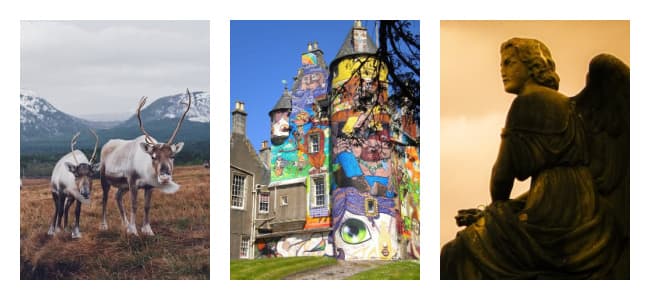
On this page I've highlighted the ones that we feel are the most unique, and often overlooked.
If you're interested in something a little different, these less-visited Scottish attractions could be the perfect fit.
- Kelburn Castle
- Corryvreckan Whirlpool
- Glasgow Necropolis
- Cairngorm Reindeer Herd
- Puffin spotting in the Hebrides
- The Govan Stones
Kelburn Castle aka Graffiti Castle
Castles play a famous and recognizable role in both the history and landscape of Scotland.
With over three hundred of these iconic structures ranging from totally restored, to enigmatic ruins, Kelburn Castle is still in a category all of it’s own.
Why? Well, one look at the image below will answer that question very quickly!
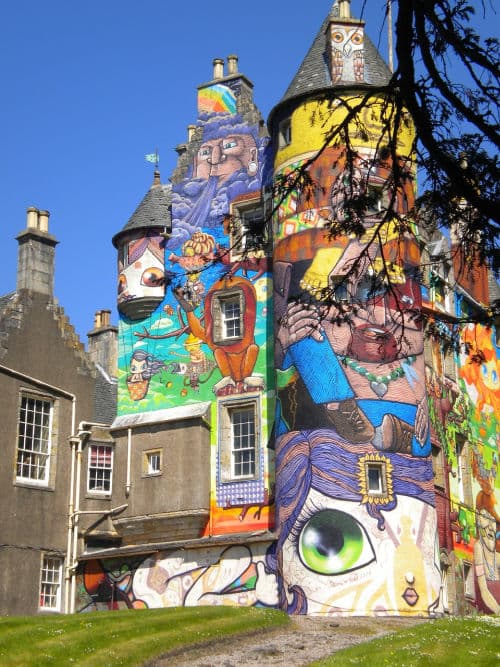
Kelburn Castle in North Ayrshire is also known as ‘Graffiti Castle’ and is the only castle in Scotland to sport this unique and colorful exterior. Whether or not it’s to your taste, it’s definitely eye catching and if you’re a castle enthusiast it’s one of Scotland’s hidden gems that you don’t want to miss.
As with most Scottish castles, Kelburn Castle has been around for centuries. Although there are no written records with exact dates, it’s believed that the original stone castle was built during the mid 13th century, possibly on the site of an existing wooden castle built approximately a hundred years earlier.
Over the next several centuries the castle underwent numerous renovations, additions and changes which resulted in the castle more than doubling in size and the gardens and estate lands becoming much more attractive.
Kelburn Castle has always been home to the Boyle family, and in the 17th century, David Boyle was given the title of 1st Earl of Glasgow. Ever since, a Boyle has held the title of Earl of Glasgow and currently Patrick Robin Archibald Boyle is the 10th Earl, with his son David Boyle next in line for the title.
The current, and 10th, Earl of Glasgow is the Boyle responsible for the now famous graffiti style art that decorates Kelburn Castle.
In 2007 the concrete exterior of the castle needed to be repaired to prevent damage to the stonework below and the Earl, along with his children David and Alice, decided to take an unconventional approach to the situation.
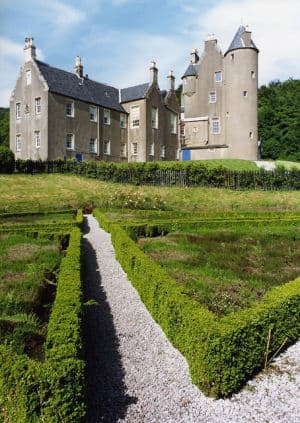 Pre-graffiti
Pre-graffiti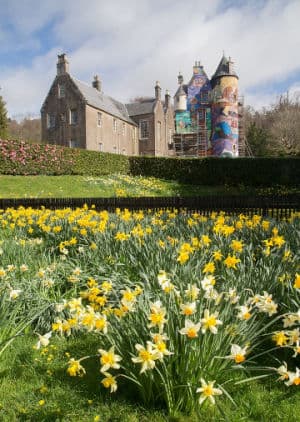 During the work
During the workPatrick Boyle hired four world-famous graffiti artists from Brazil, Nunca, Nina, and twins Otavio and Gustavo Pandolfo, along with local artists, for a totally unique project… to cover the southern exterior of this historic building with a colorful mural, graffiti-style.
The artists lived in the castle for over a month while they worked on their project.
In 2011 this exuberant display of graffiti was named one of the world’s best examples of street art by author/designer Tristan Manco.
Although the graffiti covered exterior was originally intended to be temporary and was given permission by Historic Scotland (an agency responsible for preserving and protecting Scotland’s historical monuments and buildings) to exist for three years, the Earl requested that it be allowed to remain on a more permanent basis.
An indeterminate amount of time was granted, but whether or not Kelburn Castle will be allowed to remain as Graffiti Castle long term who knows!
Visiting Kelburn Castle
The Castle and estate can be found on the west coast of Scotland, just under 35 miles from Glasgow and near the traditional seaside town of Largs.
Largs is where my Nana used to spend her summer holidays as a child in the early 1900’s. She had lovely memories of those times (which we heard about often) including eating ice cream at Nardini’s (which is still in business) and of taking the ferry over to Great Cumbrae Island for a day trip.
Given its location, Kelburn Castle is easy to find and makes a great day trip for tourists in Glasgow and the surrounding areas and coast.
Although it’s still the private home of the current Earl of Glasgow and his family, the castle, grounds and campsite are open to the public from Easter until October.
It’s also a venue that can be hired for all kinds of events including weddings, corporate retreats, family celebrations and more.
The Kelburn Estate is very family friendly and there’s something for everyone.
You may come to see this unique and unorthodox blend of history and art, but there’s plenty more for everyone to enjoy, including waterfalls, beautiful hiking trails, a walled garden, the fairy-tale inspired Secret Forest, children’s play areas and more.
Check out the Kelburn Estate website to learn more at Kelburnestate.com
Corryvreckan Whirlpool
The remote and spectacular Corryvreckan Whirlpool is the third largest, permanent, whirlpool in the world, it is also one of the most dangerous of Scotland’s hidden gems.
This famous (or is it infamous?) whirlpools churning cauldron can be found in the Gulf of Corryvreckan (aka the Strait of Corryvreckan) which flows between the Inner Hebridean islands of Jura and Scarba, just off the west coast of Scotland.
This gulf is short and narrow (a scant 2 miles long and an average of ¾ mile wide) but the immense noise of the water ricocheting off the steep rocky shorelines can be heard up to twenty miles away, and the tidal flow can reach close to 10mph during certain times of the year.
The waters are at their most volatile and dangerous during late Spring, and stormy weather at any time of year increases their power.

Although generally referred to as a whirlpool (in the singular) the Corryvreckan is not just one, clearly-defined whirlpool.
It is better described as a section of the strait where due to geography, the force of gravity, and a complex tidal system, the ocean boils, rolls and flows in several directions simultaneously, and with tremendous force.
This results in a stretch of water where there is not only the one principal whirlpool, but also multiple smaller whirlpools, eddies, water columns, and waves that can reach up to 15 feet in height, resembling walls of water.
All of these phenomena appear and disappear, only to reform in another location without warning, making this one of the most dangerous stretches of water in the world.
Although it used to be thought that a large pinnacle of rock extended from the ocean floor in the Strait of Corryvrekan, but scientists from the Scottish Association of Marine Science disproved this theory when they used sound waves to map the seabed and GPS transmitters to monitor currents (learn more HERE).
In reality, this incredibly whirlpool exists due to the very narrow channel of water that runs between the islands of Jura and Scarba, strong tides, and the configuration of Scarba’s southern coastline.
Legends & Myths surrounding Corryvreckan
The word ‘Corryvreckan’ is likely derived from the Gaelic Coire Bhreacain, with 'Coire' meaning cauldron and 'Bhreacain' (aka Breccan or Breacan) meaning speckled or spotted, or it could also mean plaid.
But, in true Scottish style, there are multiple legends surrounding the whirlpool and its name.
The Picts revered this natural wonder and even believed that it could bring dead warriors back to life.
One the ancient legends of Corryvrekan features a Viking king from Norway who falls in love with a Pictish princess from the islands and tried to prove his bravery by anchoring his boat in the whirlpool and surviving three days and three nights there.
But as it turns out he was no match for the boiling, swirling waters and he drowned on the third night
Another myth says that Cailleach Bheurra (or Cailleach Beira), a Gaelic Goddess associated with creation of landscapes and weather, especially Winter, washed her plaid in these waters, stirring up the water as she did so.
There are also other tales and stories involving either Kelpies (shape-shifting creatures of the water) or a sea witch.
History of Corryvreckan Whirlpool
The following is taken from a document published in the early-to-mid 16th century which contained details, directions and description of the Gulf of Corryvreckan.
Although published in the 16th century, the actual excerpt itself is believed to have been recorded much earlier....
The following is taken from a document detailing directions during the early-to-mid 16th century during the reign of King James V…
'Betuixt Scarba and Dura is the most dangerous stream knowing in all Europe, for manie of the seas whiche flowethe betuixt the Mulle of Cantyir and Yla passeth throwe this narrow channell and in the passyng they fall with such a great violence upon the cost of Scarba that they retourne to the cost of Dura with a great noys, making in thair returning a depe horlepoole quhairin if schippis do enter thair is no refuge but death onlie.
Nothwithstanding the best tyme that may be had of it is the tyme of full sea and low water. This passage is callit Corrbreykin'.
Source: Corryvreckan Whirlpool Scotland
The Scottish writer Martin Martin, who lived in the late 17th and early 18th century, was born on the Isle of Skye.
He is best known for his comprehensive, and fascinating, coverage of the lives and environment of the inhabitants (both human and animal) of far flung Scottish islands in his classic book entitled ‘A Description of the Western Islands of Scotland’ which was published in 1703.
In it he says of Corryvreckan…
‘It yields an impetuous current, not to be matched anywhere, the sea begins to boil and ferment with the tide of the flood, and resembles the boiling of a pot; and then increases gradually, until it appears in many whirlpools, which form themselves in sort of pyramids, and immediately after spout up as high as the mast of a little vessel, and at the same time make a loud report.’
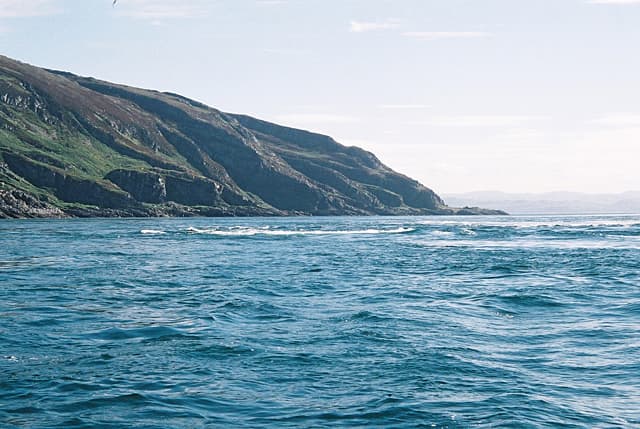
The whirlpool has doubtless claimed lives over the centuries due to both it’s ferocity and unpredictability, and there are many more ‘close calls’ by locals, fishermen and even the world-famous author George Orwell.
When in search of a quiet place to work on his novel ‘Nineteen Eighty Four’ in 1947, Orwell chose to stay temporarily on the remote and isolated island of Jura.
On a day off from writing, he took some family members (including his three-year old son) on a boat trip around Jura’s coastline as part of a camping trip.
He must have miscalculating the tides because their boat capsized and outboard motor was ripped off as they got caught in the maelstrom that is the Gulf of Corryvreckan.
Due to keeping calm, some determined rowing, and almost unbelievable good luck all the boat’s passengers survived by making it to a tiny rocky island, which sat about a mile and a half from Jura’s coastline. They were essential shipwrecked.
Luckily for George and his family, a passing lobster fisherman noticed the castaways and managed to carry out what was a tricky rescue!
How to visit Corryvreckan Whirlpool
If you’re visiting Scotland and you’re the adventurous kind, a trip to Corryvreckan Whirlpool might be the perfect off-the-beaten-path tourist experience.
So, how can you see this incredibly natural phenomenon?
Obviously the only way to get up close and personal with the whirlpools is to go out on the water by boat, but don’t be tempted to do this yourself!
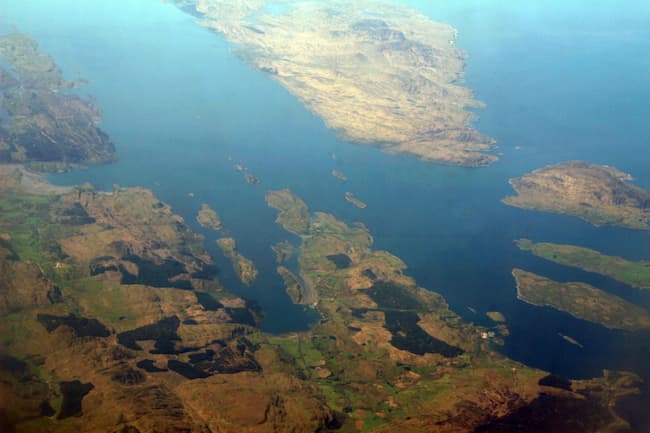 Islands to the top right are Jura (larger) and Scarba.
Islands to the top right are Jura (larger) and Scarba.
The narrow Gulf of Corryvreckan flows between them.
There
are several operators who offer boat tours of the area, including taking you
out to the whirpool.
Tours operate from the Island of Jura itself, and other islands such as from Port Askaig on the island of Islay, as well as from local ports on the Scottish mainland such as Crinan Port or Craobh Marina, both on the west coast of Argyll and Bute.
A few to check out include:
The islands and ocean in this part of the world are teeming with wildlife and boat tour operators also offer wildlife spotting trips, including the opportunity to see whales, puffins, seals, sea eagles, even Golden Eagles and more.
If you’re staying on the island of Jura it is possible to lookout over the Gulf of Corryvreckan from the northern end of the island.
But be warned, this is not a simple road trip. You can only take your car so far, and covering somewhere between seven and nine miles on foot is required!
Alternatively you could try hiring a four-wheel drive vehicle.
The Glasgow Necropolis
The city of Glasgow is a bona-fide tourist destination and features many very popular attractions including museums, art galleries, gardens and parks, distilleries and more.
‘More’ includes the unique and intriguing Glasgow Necropolis, a theatrical and sprawling cemetery built during the early 19th century which covers thirty-seven acres (one of the largest in the world) and is the resting place of approx. 50,000 people of multiple faiths.
Although the Glasgow Necropolis isn’t remote, isn't exactly hidden, and is a tourist attraction, it’s one that many potential visitors either don’t know about, or don’t add to their list of ‘must see’ locations... hence we feel it fits on this page.
Given that it is steeped in history, the stuff of legends, and a tangible connection to Scots both famous and humble from centuries past, we feel it deserves to be on this list of Scotland’s hidden gems.
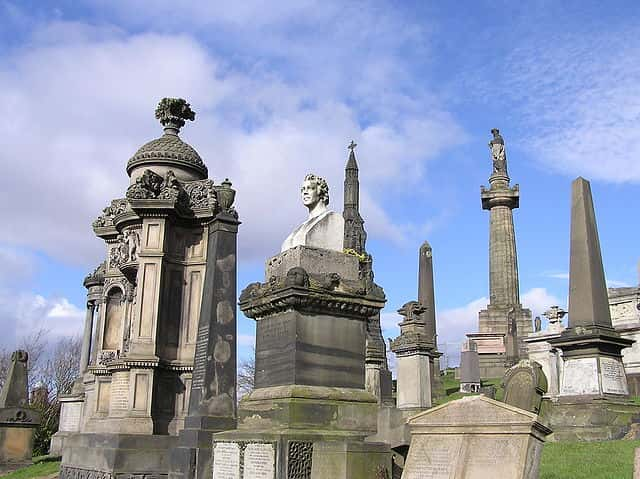
Glasgow and its surroundings are on fairly level ground, but the Glasgow Necropolis was built on an area of relatively high ground where there was already a park and arboretum with panoramic views across the city.
Immediately to the west of the necropolis was Glasgow Cathedral (aka St. Mungo’s Cathedral or the High Kirk of Glasgow) and a bridge called ‘The Bridge of Sighs’ connected the two locations and was used for funeral processions.
When you visit you will cross this historic bridge to enter the cemetery, first passing through elaborate gates that were added a few years later.
History of the Glasgow Necropolis
Although its original concept planned for it to consist of
catacombs beneath the hill (to help defend against grave robbers of the time),
in line with the Victorian era in which it was born, this inter-denominational cemetery
became an elaborate creation.
It was designed by eminent architects and sculptors of the time, and which includes ornate mausoleums, crypts and tombs, graves (marked and unmarked), memorials for several groups (including Korean Veterans and stillborn babies) along with tranquil and beautifully landscaped gardens that everyone can enjoy.
People of all religious denominations, all levels of society and all types of employment (including many from the arts, politics, the ministry and across all branches of the military) are buried in the Glasgow Necropolis.
Although unusual at the time, the necropolis kept records of everyone buried there including name, sex, age and even cause of death.
1833. Joseph Levi – a Jewish jeweler, was the first person to be buried in the Glasgow Necropolis
1834. Elizabeth Miles – stepmother to the head gardener and superintendent to the Necropolis was the first Christian to be buried there.
Over the decades many well-known Scots joined Joseph and Elizabeth, including Thomas Thomson, Scottish chemist and mineralogist whose work is still reflected in chemistry today (1852), David Price Miller, showman and magician, founder of the Adelphi Theaters (1873), Hugh Tennent, founder of the world famous Tennent Brewery (1890) and Sir Thomas Lipton, founder of the Lipton Tea empire (1931).
Corlina Lee, the ‘Queen of the Gypsies’ was born into a prominent original Romany family and after she married George Smith who also belonged to another Romany dynasty they became both gypsy royalty and famous, in the UK at the time (1900) .
Even though they were buried elsewhere, many other famous names are memorialized in the Glasgow Necropolis and monuments have been erected in their honor, including John Knox, leader of the Protestant Reformation in Scotland.
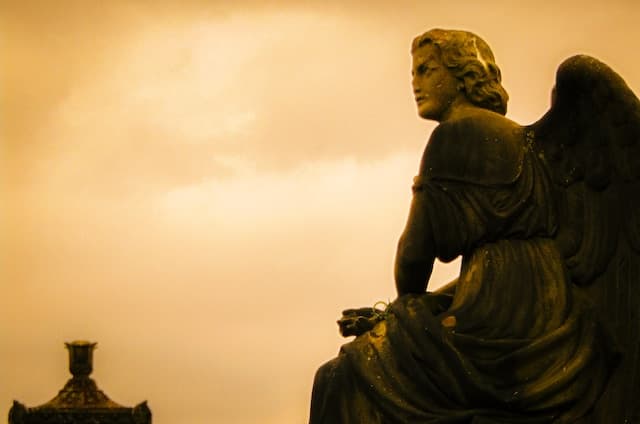
Visiting the Glasgow Necropolis
The Glasgow Necropolis is close to the city center attractions and is easy to find and to get to, and is open to the public and free of charge from 7am to 4:30pm.
It is for pedestrian access only, and as it covers a large area and the paths are winding and sometimes uneven, be prepared and wear comfortable walking shoes!
Glasgow’s weather is often chilly, and wet, and the location is elevated so it’s also wise to dress appropriately.
If you climb to the top layer of this convoluted necropolis you’ll get an awesome view of the city of Glasgow (weather permitting of course!).
Guided walking tours can be found courtesy of The Friends of Glasgow Necropolis and you can also buy Guidebooks on their website.
The Cairngorm Reindeer Herd
As unexpected as it is unforgettable, the Cairngorm Reindeer Herd is the only free-ranging herd of Reindeer in the UK and they’re a unique and fascinating addition to the agenda of tourists who visit the Highlands.
After all, how many of us can say we’ve seen a real, live reindeer living its best life?
The location, terrain, climate and flora in the Cairngorms are so similar to those of native reindeer in Lapland that it can easily support the herd, which today numbers around 150 reindeer.
Reindeer are perfectly adapted to living in cold, snowy conditions, and the stunning natural beauty of the Scottish Highlands is the perfect backdrop to Cairngorm Herd.
Although there are no wild Reindeer in Scotland today, they are native to Scotland, and were recorded to have grazed in (and been hunted in) far northern Scotland up until around eight hundred years ago when they became extinct in the wild, likely due to overhunting and to climate change at the time.
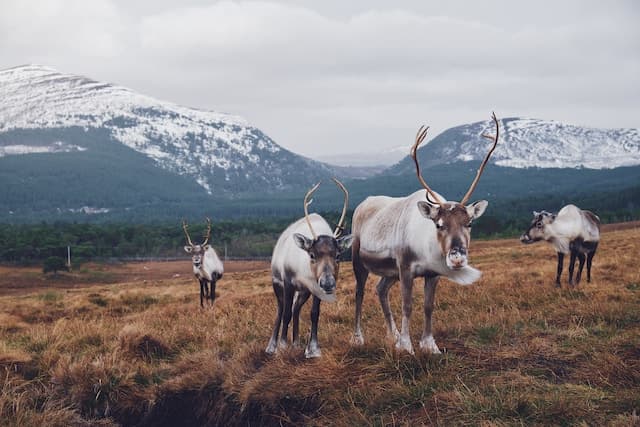
The Cairngorm Reindeer Herd was founded in 1952 by Mikel Utsi and Ethel Lindgren, a Swedish couple, and reindeer were brought by ship from Sweden to Scotland in small numbers over a period of several years.
Over the past sixty-plus years the herd has grown to its current size, and it has approximately 6,000 acres to roam and graze on.
The Cairngorm Reindeer Center is located at Glenmore Village, just outside the tourist and ski resort of Aviemore in the Scottish Highlands.
Visiting the Cairngorm Reindeer Herd is a unique and magical, family-friendly experience that will leave you with wonderful memories.
How to visit the Cairngorm Reindeer Herd
There are two ways to see these gentle, friendly Reindeer. You can join a Hill Trip or a enjoy a Paddock Visit.
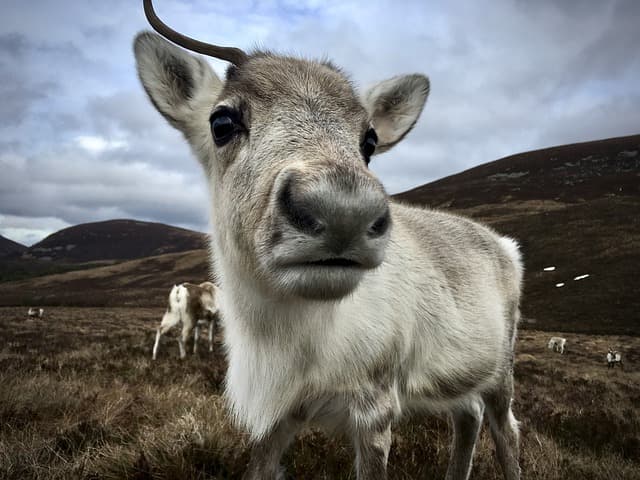
The Hill Trip involves a fair amount of walking on terrain that can be steep, rocky, wet and often snowy.
It’s not an extreme experience
and most able-bodied adults and older children will manage it just fine for
most of the year (there are limitations depending on season and weather).
For families with smaller children, the elderly, or anyone who isn’t sure footed, the Paddock Visit is a better fit. Follow the advice on the herds website re clothing and footwear especially if you’re going to be going on the Hill Trip.
Be aware that Hill Trips fill up fast, and tickets are released 30 in advance, so plan ahead! Paddock Visits tend to more easily available but they also fill up quickly, especially during holiday seasons.
If you can’t visit in person, you can adopt a specific member of the herd (or choose to support the herd in general) for one year HERE. For your donation you get a photo of your reindeer, a certificate, and a bi-annual newsletter!
Check out the official Cairngorm Reindeer Herd website which has everything you ever wanted to know about their herd and how you can enjoy it too.
Puffin spotting on the island of Lunga
The uninhabited island of Lunga may not yet be a feature on your ‘Places I must visit in Scotland’, but honestly we think it should, especially if you’re a nature or wildlife enthusiast!
This small island (it’s only around 200 acres in size) is part of the Treshnish Isles of the Inner Hebrides of Argyle and Bute, and is found off the west coast of Scotland not far from the much larger and more well-known Isle of Mull.
These islands are part of the Loch Na Keal National Scenic Area and Lunga is a bird reserve (a protected area and breeding colony for many coastal birds, including the endearing and unique Puffin).
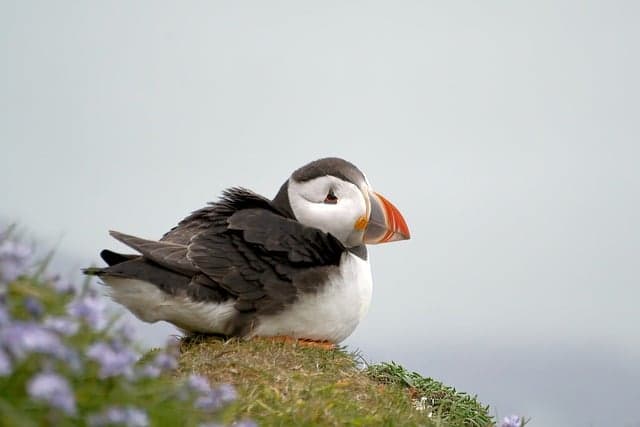
Puffins (aka ‘Sea Parrots’, or as they’re sometimes called by locals ‘Clowns of the sea’) can be found nesting on the cliffs of Scotland’s western coastlines and islands from approx. March until August each year.
These spunky little birds with their distinctive and colorful beaks, and almost quizzical expressions, spend the rest of the year at sea, often over waters close to the eastern coast of Canada and USA.
They often don’t touch land for all those months and can rest/sleep bobbing on the waves.
How to visit the Puffins on Lunga
The island of Lunga has no human residential population, and is a daytrip destination.
You can go by boat from several ports or islands including Oban on the mainland and the Isles of Mull or Ulva, and a stop off at Lunga is often part of trips that are going to more than one island in a day.
For example you can take a tour from the Isle of Mull to the Isle of Staffa (where you’ll find Fingal’s Cave, a sea cave with spectacular rock formations and acoustics), with a stop on Lunga to get up close and personal with the puffins.
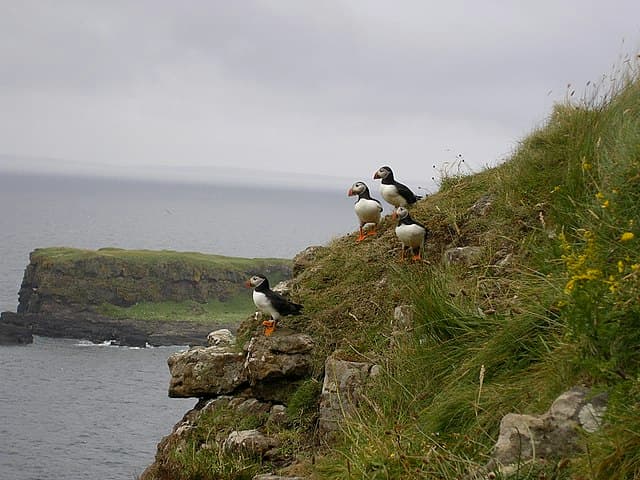
The terrain on Lunga is steep and rocky, with an uneven
grass-covered plateau and is blanketed by Puffins and other ocean going birds during
the late Spring and Summer months.
You may well be surprised at how UN-afraid of you the adorable Puffins are.
Puffins are bright, social, charismatic birds and are as curious about you as you are about them so make sure you have your camera or cell phone handy and fully charged!
Check out this video on Youtube to get a glimpse of Lunga and it’s famous (and adorable) residents.
The Govan Stones
Scotland is steeped in fascinating, tumultuous history, and there are relics and evidence of times gone by everywhere you look.
Govan Old Parish Church in Glasgow is home to some incredible pieces of Scotland's history that you may never have heard of, the Govan Stones.
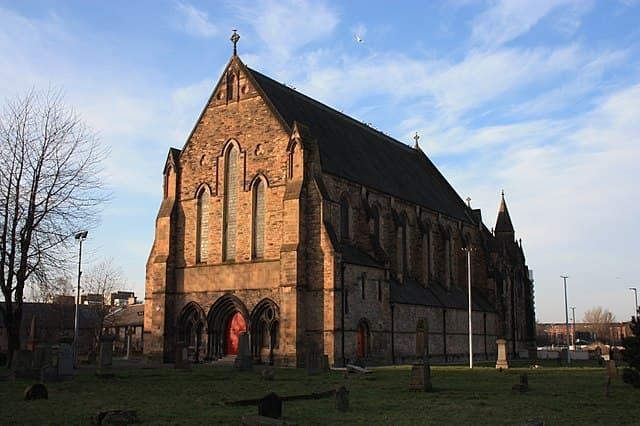
These priceless artifacts are stunning to look at, and they demonstrate the fascinating interaction between Pictish, Briton and Viking people in Scotland centuries ago.
Govan Old Parish Church sits on the banks of the River Clyde in Glasgow and is believed to be the oldest known Christian site and burial ground along the banks of the river, with Christian activity dating back to as early as the 5th or 6th century.
During archaeological excavations
foundations were uncovered which indicate that a wooden church was likely in
place during this early Medieval time period.
The church now serves as a heritage center (established by the Govan Heritage Trust) which houses the priceless, and internationally significant, Govan Stones.
In 1993 Historic Environment Scotland designated Govan Old Parish Church, the churchyard and the Govan Stones as a Scheduled Monument.
About the Govan Stones
During the 9th century this area of Scotland (along with most of Scotland’s coastal areas and northern England) was the object of raids and invasions by Vikings and Govan and the surrounding area took on political importance, becoming a center of power for the new Kingdom of Strathclyde.
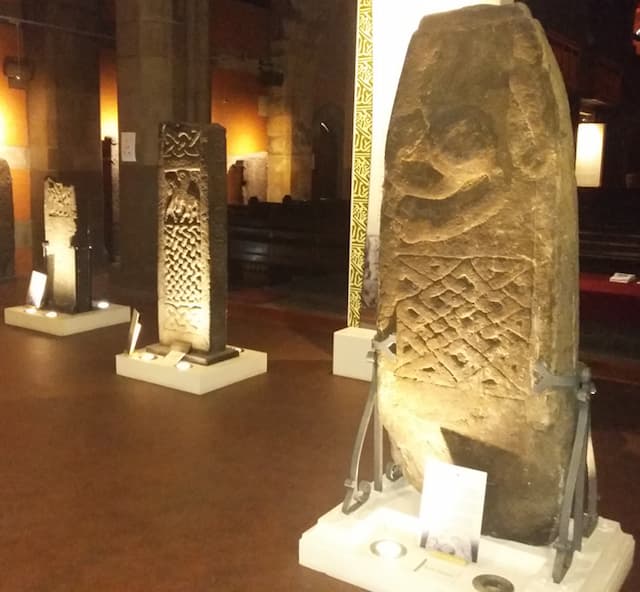
Between the 9th and 11th centuries Vikings settled in many areas and there was a certain amount of blending of cultures and people.
The Govan Stones themselves are visible proof of the co-existence and blending of Pictish, Celtic and Norse customs, burials and memorials during the Medieval period.
The earliest Christian gravesites at Govan Old Parish Church date back to the 5th century but most of the gravestones and markers you’ll find in the churchyard are for people who lived, and died, between the 16th and 19th centuries.
The world-renowned Govan Stones consist of thirty plus artifacts including an impressive Viking era stone sarcophagus.
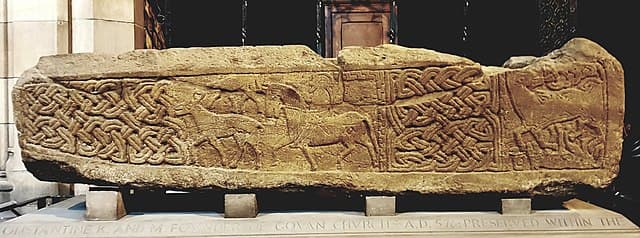
The name Constantine is associated with the sarcophagus, but there is still ongoing debate as to which historical Constantine it belonged to, or was dedicated to.
It could be linked to King Constantine I, King of the Picts in the 9th century. It may also have been dedicated to Saint Constantine, the patron saint of the church itself.
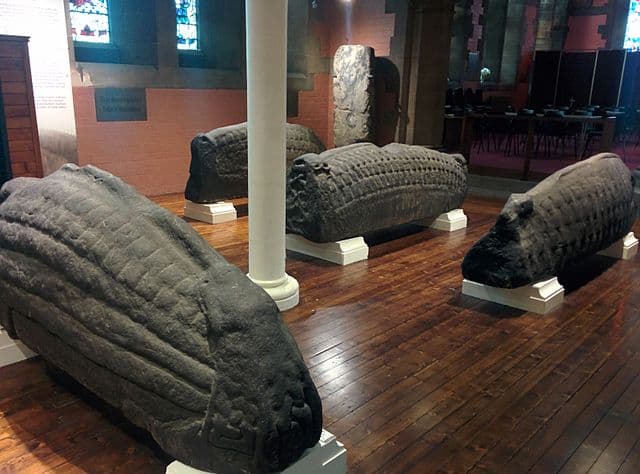
The other relics include huge grave markers, stone slabs and stone crosses, plus some stunning ‘hogback’ stones believed to have been used by the Vikings to mark important graves.
All of these relics feature intricate Celtic, Pictish and Norse/Scandinavian carvings and are quite incredible.
Although the Govan Old Parish Church and the Govan Stones are one of the lesser known and off-the-beaten-track experiences, being around them is an experience you won’t forget in a hurry.
How to visit the Govan Stones
Govan Old Parish Church sits on the bank of the River Clyde in Glasgow and it's pretty easy to get there either by using the Subway, bus or by car.
The church is just a few minutes walk from the Govan subway station and there are multiple bus lines you can ride from Glasgow and further afield.
The Govan Stones themselves are all displayed within the church and are protected from the elements.
It's open to visitors from 1:00pm-4:00pm, seasonally from April 1 through October 31st.
Admission is free (donations are always welcome). Guided and group tours can be arranged.
- Home
- Scotland's Hidden Gems